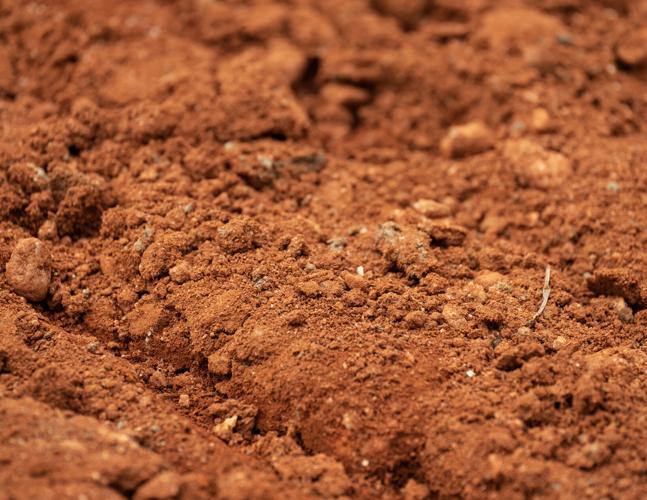The primary colors of Lake Martin are blue, green and red: blue sky and water; green pine needles and leaves; and red clay.
Scratch the surface around Lake Martin, and chances are high that you’ll find red. It’s the iconic color of our area, the orange-red color of roads, eroded shorelines and disturbed soil.
Some lake-dwellers don’t want to wash their cars – red-tinted tires and fenders driving through a city serves as a badge of honor, a symbol of the red dirt roads that lead to their cabins around Lake Martin.
But what is red clay? Why is it here? And what makes it red?
All clays start out as rock. Over time – lots and lots of time – rain and wind weathers the rocks, slowly dislodging particles. The tiny particles that become clay are miniscule, more than 1,000 times smaller than a grain of sand, which also comes from weathered rock. In scientific terms, a soil particle that is less than .002 mm in diameter is called clay. Because the particles are so small, they have more surface area and not much interior area … so they are more reactive than a bigger chip off the old block.
Scientists call red clay soils “Ultisols,” a name that comes from the word “ultimate,” since these super-fine particles are the ultimate result of weathering in humid climates, taking hundreds of thousands of years to form.
The composition of the rock determines the color of the clay. In the case of the red clay found here, iron oxides provide the deep red hue. Iron oxide is a fancy term for rust. The more iron in the clay, the redder it is.
We do have other colored clays in Alabama, most notably yellow and white. But red is, by far, the most common in our area.
These soils are typically acidic, and if you plan to garden in red clay, you will almost certainly need to add organic material and lime to sweeten the soil.
Red clays are found mostly in humid temperate and tropical areas and account for more than 8 percent of the ice-free land around the world, such as in Africa, Asia and South America. It is the primary subsoil found in the Southeast U.S.
Lake Martin is in the Piedmont Plateau where most of our soil comes from eroded granite, hornblende or mica schists. If you ever see bits of shiny or sparkly soil around the lake, it probably started as a larger piece of mica.
Our soil is primarily red clay or a sandy loam. The uppermost layer of dirt is likely dark brown topsoil, created from decomposing organic matter, such as leaves, pine needles and rotting wood. Often just below the topsoil is a lighter colored, orange or red-tinted sandy, loamy soil. And below that is usually dense red clay.
Because clay particles are so small and reactive, they bind strongly with water, which can cause clay to double its size, or half its size depending on how much water is available. During dry periods, red clay roads contract and become dusty. But when the rains fall, those same roads can become swollen, slick and sticky with bulging ruts, as water molecules are held between the very fine clay particles. The oxides in red clay hold onto water for a long time, making the soil sticky and creating puddles that can remain long after the surrounding topsoil drains and dries.
Anybody who has walked a red clay road after a rain and then had to leave their boots at the door understands how sticky red clay can be – that’s because as water is squeezed out of the wet red clay, the very small particles form bridges that hold the clay together.
That stickiness is also why red clays can be used to make pottery, paints and dyes. As water dries out of clay, the clay particles bind to whatever theyt touch, be they Vibram soles, white T-shirts or each other in the wall of a clay pot.
By the way, if you’re curious what’s under the grass and topsoil someplace, you don’t need a shovel to find out. Just take a look at the fire ant mounds. Fire ants building nests underground bring the excavated dirt from their tunnels to the surface. So, if you see a red fire ant mound, it’s because the hard-working ants are tunneling in red clay underground.
Some information for this article came from The Alabama Cooperative Extension System, The University of Pennsylvania, the U.S. Department of Agriculture and sciencing.com.










